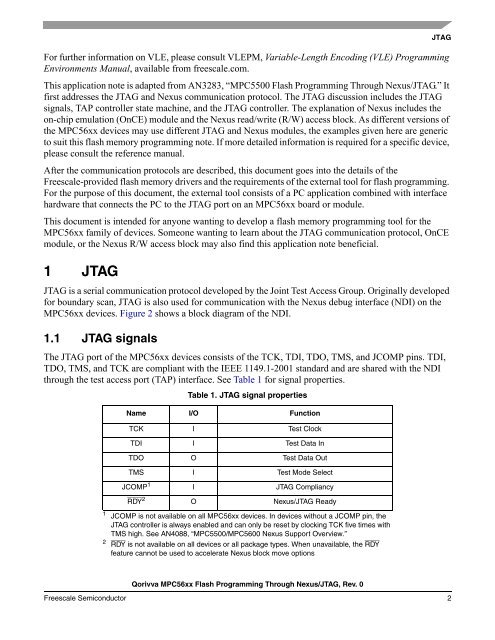AN4365, Qorivva MPC56xx Flash Programming Through Nexus/JTAG
AN4365, Qorivva MPC56xx Flash Programming Through Nexus/JTAG
AN4365, Qorivva MPC56xx Flash Programming Through Nexus/JTAG
Create successful ePaper yourself
Turn your PDF publications into a flip-book with our unique Google optimized e-Paper software.
For further information on VLE, please consult VLEPM, Variable-Length Encoding (VLE) <strong>Programming</strong><br />
Environments Manual, available from freescale.com.<br />
<strong>Qorivva</strong> <strong>MPC56xx</strong> <strong>Flash</strong> <strong>Programming</strong> <strong>Through</strong> <strong>Nexus</strong>/<strong>JTAG</strong>, Rev. 0<br />
<strong>JTAG</strong><br />
This application note is adapted from AN3283, “MPC5500 <strong>Flash</strong> <strong>Programming</strong> <strong>Through</strong> <strong>Nexus</strong>/<strong>JTAG</strong>.” It<br />
first addresses the <strong>JTAG</strong> and <strong>Nexus</strong> communication protocol. The <strong>JTAG</strong> discussion includes the <strong>JTAG</strong><br />
signals, TAP controller state machine, and the <strong>JTAG</strong> controller. The explanation of <strong>Nexus</strong> includes the<br />
on-chip emulation (OnCE) module and the <strong>Nexus</strong> read/write (R/W) access block. As different versions of<br />
the <strong>MPC56xx</strong> devices may use different <strong>JTAG</strong> and <strong>Nexus</strong> modules, the examples given here are generic<br />
to suit this flash memory programming note. If more detailed information is required for a specific device,<br />
please consult the reference manual.<br />
After the communication protocols are described, this document goes into the details of the<br />
Freescale-provided flash memory drivers and the requirements of the external tool for flash programming.<br />
For the purpose of this document, the external tool consists of a PC application combined with interface<br />
hardware that connects the PC to the <strong>JTAG</strong> port on an <strong>MPC56xx</strong> board or module.<br />
This document is intended for anyone wanting to develop a flash memory programming tool for the<br />
<strong>MPC56xx</strong> family of devices. Someone wanting to learn about the <strong>JTAG</strong> communication protocol, OnCE<br />
module, or the <strong>Nexus</strong> R/W access block may also find this application note beneficial.<br />
1 <strong>JTAG</strong><br />
<strong>JTAG</strong> is a serial communication protocol developed by the Joint Test Access Group. Originally developed<br />
for boundary scan, <strong>JTAG</strong> is also used for communication with the <strong>Nexus</strong> debug interface (NDI) on the<br />
<strong>MPC56xx</strong> devices. Figure 2 shows a block diagram of the NDI.<br />
1.1 <strong>JTAG</strong> signals<br />
The <strong>JTAG</strong> port of the <strong>MPC56xx</strong> devices consists of the TCK, TDI, TDO, TMS, and JCOMP pins. TDI,<br />
TDO, TMS, and TCK are compliant with the IEEE 1149.1-2001 standard and are shared with the NDI<br />
through the test access port (TAP) interface. See Table 1 for signal properties.<br />
Table 1. <strong>JTAG</strong> signal properties<br />
Name I/O Function<br />
TCK I Test Clock<br />
TDI I Test Data In<br />
TDO O Test Data Out<br />
TMS I Test Mode Select<br />
JCOMP1 I <strong>JTAG</strong> Compliancy<br />
RDY 2<br />
O <strong>Nexus</strong>/<strong>JTAG</strong> Ready<br />
1<br />
JCOMP is not available on all <strong>MPC56xx</strong> devices. In devices without a JCOMP pin, the<br />
<strong>JTAG</strong> controller is always enabled and can only be reset by clocking TCK five times with<br />
TMS high. See AN4088, “MPC5500/MPC5600 <strong>Nexus</strong> Support Overview.”<br />
2<br />
RDY is not available on all devices or all package types. When unavailable, the RDY<br />
feature cannot be used to accelerate <strong>Nexus</strong> block move options<br />
Freescale Semiconductor 2












